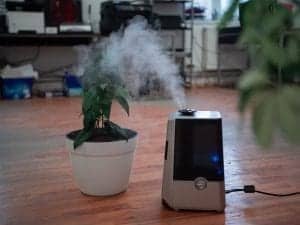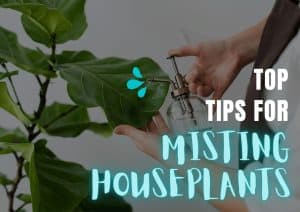How To Shower Houseplants Without Killing Them?
- Lakeisha Ethans
- June 11, 2023
If you buy something using the retail links in our articles, sometimes we earn a small affiliate commission. This does not impact the products we recommend.
When you imagine watering houseplants, you likely picture either a watering can or a mister – these tools offer a simple, small, and controlled way to determine exactly how much water each plant is receiving. The truth however is that most plants would benefit tremendously from a powerful downpour that mimics natural rainfall as opposed to being wetted with a gentle trickle.
And it’s relatively easy to do this with a shower without the risk of causing them harm.
To shower houseplants without killing them you should avoid extremes, either in the form of water pressure or temperature (62-72 degrees F is best) and whilst holding the showerhead in hand rinse the plants from a height of 2-3ft until the foliage is clean of dust, debris and pests.
Sixty seconds of showering should be long enough to clean the leaves of most houseplants whilst at the same time soaking the soil to give the plant a drink, and in terms of frequency, showering your indoor jungle once per quarter in amongst regular watering is a good habit to adopt.
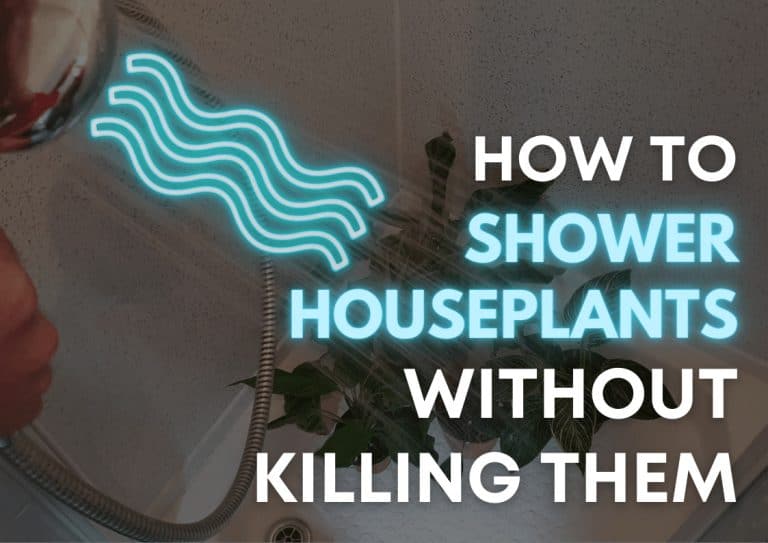
How should I shower my houseplants?
Begin by cleaning your shower area. Many leftover chemicals can be sitting on the floors of your shower area or bathtub. Shampoos, soaps, and other products can seep into the soil of your houseplants (especially if the roots extend out through the pot drainage holes) damaging them or harming their growth.
Next, prepare your plants.
Remove any dead or decaying leaves that might block healthy leaves from being rinsed. This is part of being a good plant parent and is simply made easier and more convenient when the plant is in the shower tray and any mess made can be easily controlled.
Now it’s time to turn the showerhead on, pointing the shower away from the plants initially to keep pressure nice and low, as too-high pressure can damage stems and leaves. You want to use very gentle directed pressure to “wash” individual leaves one by one to clean them well. This flushes various unwanted salts, pests, and dust off the foliage.
After showering, allow your plants to thoroughly drain so they’re no longer dripping before returning them to their trays and designated places. Returning them too fast won’t just cause a mess – it can also increase the risk of your plants reabsorbing the drained water, which will contain the flushed-out salt you don’t want.
About half an hour to an hour is sufficient.
Some people may opt to use a garden hose or a tap on a sink to “shower” their plants. These are perfectly viable options but you’ll have a little more difficulty controlling the flow and dispersal of water that is being directed towards the plants.
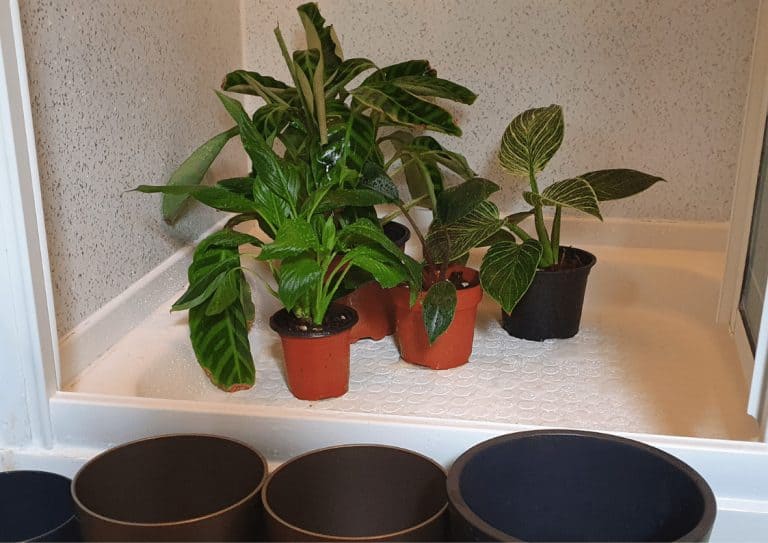
What temperature is best for showering houseplants?
The best temperature for showering houseplants is between 62 and 72 degrees Fahrenheit, with an absolute optimum of 68 degrees F. This means that water should be between cool and tepid, never venturing too far into warm or cold territories.
This is due in part to the fact that plants need sufficient dissolved oxygen in water to optimally absorb nutrients and lower the risk of encountering pathogenic organisms, such as bacteria and molds.
When water is too hot, dissolved oxygen levels begin to reduce, with warm waters also promoting the existence of harmful microorganisms in the soil.
Is shower water truly safe for houseplants?
Shower water is broadly safe for houseplants, however the type of chemical or purifying treatment that your shower water receives can be of concern to some sensitive or finicky plant species.
Shower water is, essentially, tap water. This means that most common showers will utilize water that is filled with impurities. Some of these impurities are good for plants, like minerals that can provide flora with nutrients. However, many of those impurities are chemicals that can stunt plant growth or even harm more sensitive plants.
Most plants don’t mind tap water or distilled water and will be fine when watered with it, though they may not achieve their utmost growth with it. Many plant owners, however, happily use tap and shower water for their flora with no issue, and in most cases, you’ll have that same experience.
Do note that some shower water may be treated with various other chemicals that make things even less safe.
If your water is treated with a water softener, for example, then you absolutely cannot use that water on your plants. Look into your water supply and how it’s processed before determining whether or not your shower water is suitable for plants.
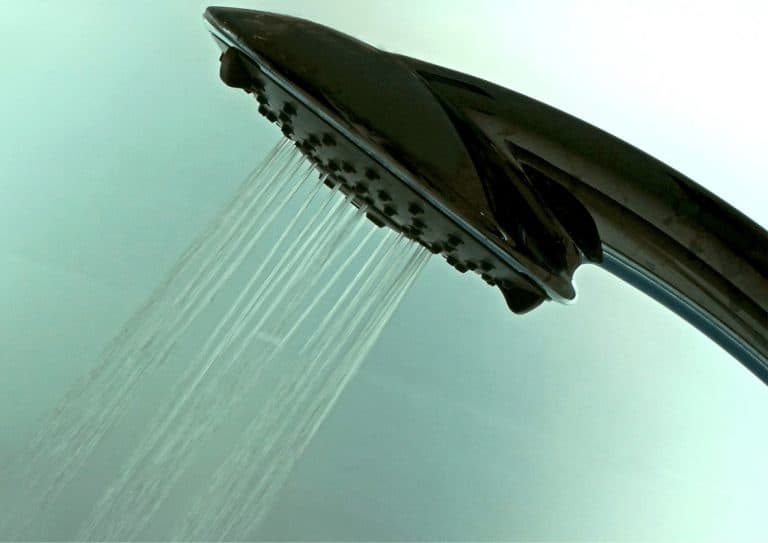
Are there houseplants not suited to being showered?
If you have plants that notoriously prefer very little water, are extremely susceptible to root rot, or are grown in soil that tends to hold too much water, they may not be suitable for showering. Certain plants also have dormancy periods during which they should not be watered, so you may not be able to shower all your plants throughout the year.
Plants which have thin or delicate foliage are more susceptible to damage incurred by the pressure of water emitted by the showerhead.
If your plants are low-light plants or aren’t often in any form of natural sunlight or bright artificial light, showering may also not be suitable. This is because plants need light to process the water they consume, and without that light, they’re left with a lot of extra water and no interest in drinking it, risking root rot.
Remember that there are always exceptions to general rules, so keep an eye on your plants after you first shower them to ensure that everything is fine.
Take home message
You can safely shower your houseplants without too many concerns. Simply allow them to sit under gentle water pressure until their pots are full, let them soak for a while, then drain and return them to their original location. Cool or tepid water temperatures between 62 and 72 degrees is best for maximum nutrient uptake and moisture absorption.
You will however have to be sure that your houseplants are suited to being showered before taking the jump into this new habit. This is especially true for very sensitive plants, plants that dislike too much moisture, or plants undergoing dormancy. Some plants may dislike the chemicals found in normal shower water, but most plants are completely fine with this watering style.
Frequently asked questions
You should begin by cleaning your shower area and preparing your plants by removing any dead or decaying leaves. Then, turn the showerhead on, pointing the shower away from the plants initially to keep pressure nice and low. Use very gentle directed pressure to “wash” individual leaves one by one to clean them well. After showering, allow your plants to thoroughly drain so they’re no longer dripping before returning them to their trays and designated places.
The best temperature for showering houseplants is between 62 and 72 degrees Fahrenheit, with an absolute optimum of 68 degrees F. This means that water should be between cool and tepid, never venturing too far into warm or cold territories.
Shower water is broadly safe for houseplants, however, the type of chemical or purifying treatment that your shower water receives can be of concern to some sensitive or finicky plant species. Do note that some shower water may be treated with various other chemicals that make things even less safe.
If you have plants that notoriously prefer very little water, are extremely susceptible to root rot, or are grown in soil that tends to hold too much water, they may not be suitable for showering. Certain plants also have dormancy periods during which they should not be watered, so you may not be able to give them a showering year round.

Lakeisha Ethans
Houseplant Writer
Mother to two humans and hundreds of plant babies. Lakeisha uses her 15 years of experience as a content writer to specialise in simplifying what you need to know to grow and care for all indoor plants.
Similar Posts
The Best Humidifiers For Houseplants (Create A Jungle Atmosphere)
If you are a lover of tropical houseplants then adding one of these humidifiers in amongst your foliage could be the smartest move you make all year.
Top Tips For Misting Your Indoor Plants
We'll cover the bases involved with misting your houseplants including how often you should ideally plan to mist your foliage.

